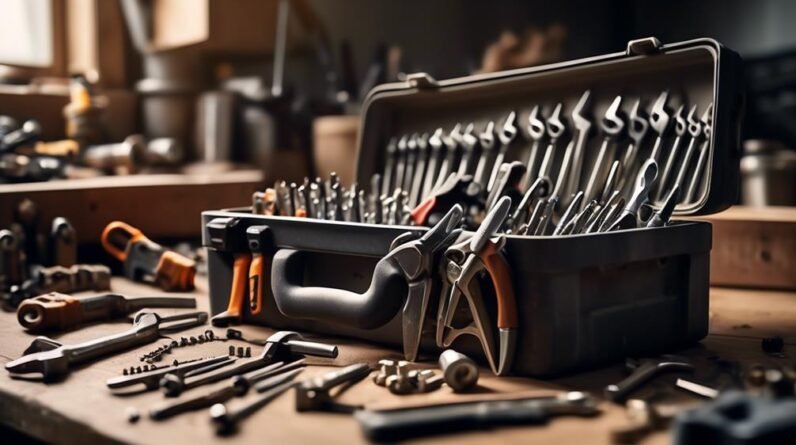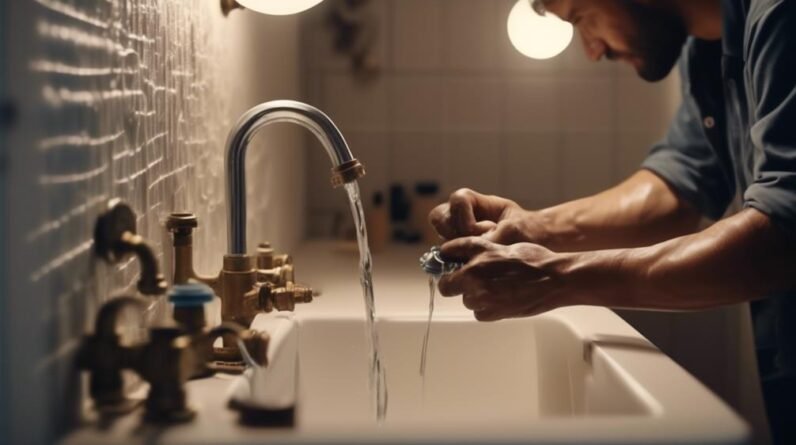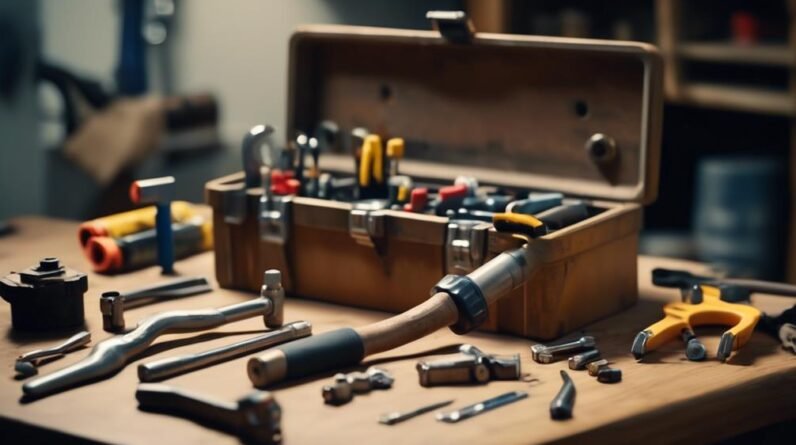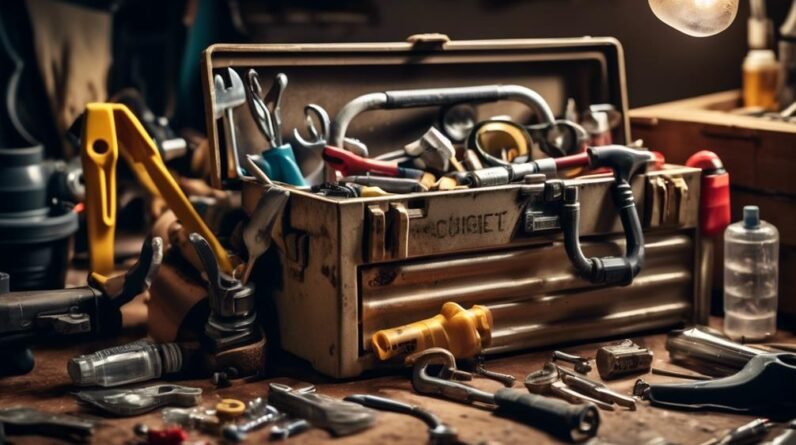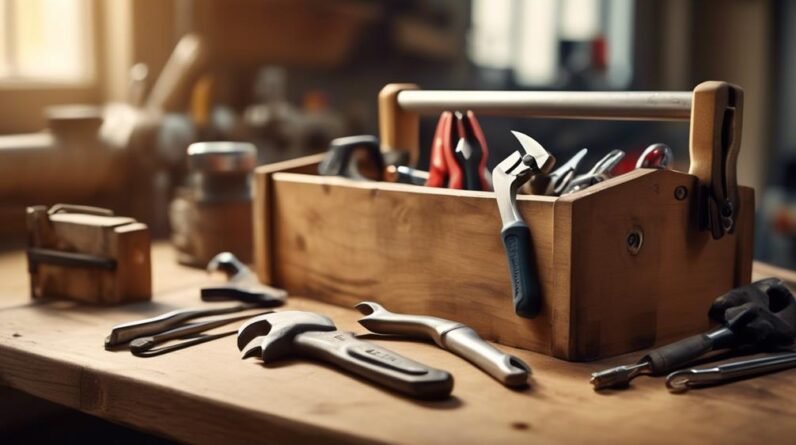
Looking to save a few bucks on home maintenance? We've got you covered with some budget-friendly DIY hacks and repair tips that will have your place looking good as new. From fixing those pesky leaky faucets to patching up holes in the wall, we've got the solutions you need to tackle common household issues. But that's not all – we're about to reveal a secret trick that will leave your doors squeak-free and your tiles looking flawless. So, if you're ready to take matters into your own hands and transform your home without breaking the bank, then keep reading. Trust us, you won't want to miss out on these affordable DIY maintenance hacks.
Key Takeaways
- Choose the right tools for each repair task to ensure successful and efficient maintenance.
- Regularly check and replace worn-out parts to prevent leaks and further damage.
- Take proper measures to unclog drains and prevent future build-up by avoiding pouring harmful substances down the sink.
- Perform routine maintenance on doors and tiles to ensure smooth operation and an aesthetically pleasing appearance.
Fixing Leaky Faucets
If you're tired of the constant drip-drip-drip and the wasted water, it's time to roll up your sleeves and tackle that leaky faucet head-on. Fixing a leaky faucet may seem like a daunting task, but with the right tools and a little know-how, you can save money and prevent future leaks.
To start off, it's important to choose the right tools for faucet repair. You'll need an adjustable wrench, Phillips and flathead screwdrivers, needle-nose pliers, and plumber's tape. These tools will help you disassemble the faucet, identify the problem, and make the necessary repairs.
Before you begin any repairs, make sure to turn off the water supply to the faucet. This can usually be done by shutting off the valve under the sink. Once the water is turned off, you can start disassembling the faucet.
To prevent future leaks, it's essential to replace any worn-out parts, such as the rubber gaskets or O-rings. These can cause leaks over time due to wear and tear. Additionally, applying plumber's tape to the threaded connections will create a watertight seal and prevent leaks.
Patching Holes in the Wall
Now that you've successfully fixed that leaky faucet, it's time to tackle another common household issue – patching holes in the wall. Whether it's from a misguided picture hanging attempt or a doorknob mishap, holes in the wall are an eyesore that can be easily remedied. Here are some tips to help you patch those unsightly holes and make your walls look as good as new:
- Start by cleaning the hole and removing any loose debris or drywall fragments. This will ensure a smooth and even surface for patching.
- For small holes, use spackle or putty to fill in the gap. Apply the filler with a putty knife, making sure to spread it evenly. Allow it to dry completely before sanding it down to a smooth finish.
- For larger holes, cut a piece of drywall slightly larger than the hole and fit it snugly into place. Secure it with drywall screws or adhesive and then cover the seams with joint compound. Once dry, sand it down and apply multiple coats if necessary.
- Once the patch is complete, you can paint over it to match the surrounding wall. Use a brush or roller to apply the paint, and feather the edges to blend it seamlessly.
Alternatively, if you want to add a decorative touch, you can cover the patched hole with wallpaper. Measure the hole and cut the wallpaper to fit, then apply it using wallpaper adhesive. Smooth out any air bubbles or wrinkles, and trim off any excess. This is a great way to add personality to your walls while hiding any imperfections.
With these simple steps, you can easily patch holes in your walls and restore their pristine appearance. So grab your tools and get started on this DIY project today!
Unclogging Drains
To effectively unclog drains, follow these practical steps to keep your pipes flowing smoothly. Dealing with a clogged drain can be frustrating, but with the right methods, you can easily clear the blockage and prevent future clogs. One of the most effective drain cleaning methods is to use a plunger. Simply place the plunger over the drain, ensuring a tight seal, and pump it up and down vigorously. This will create pressure and suction, helping to dislodge the clog. Another method is to use a mixture of baking soda and vinegar. Start by pouring half a cup of baking soda down the drain, followed by half a cup of vinegar. Let the mixture sit for about 30 minutes, then flush it with hot water. The chemical reaction between the baking soda and vinegar helps break down the clog. To prevent clogged drains in the first place, be mindful of what you put down the drain. Avoid pouring grease, coffee grounds, or food scraps down the sink. Use a drain strainer to catch hair and other debris. Regularly flushing your drains with hot water can also help prevent build-up. By following these simple steps, you can effectively unclog drains and keep them clear in the future.
Repairing Squeaky Doors
Repairing squeaky doors can be a simple and effective DIY project that will eliminate annoying noises and ensure smooth operation. Here are some practical tips to help you get started:
- Lubricating door hinges: Apply a lubricant such as WD-40 or silicone spray to the hinges. Start by cleaning any dirt or debris from the hinges with a rag. Then, spray a small amount of lubricant onto the hinge pins and move the door back and forth to distribute the lubricant evenly. This will reduce friction and eliminate squeaks.
- Tightening loose door screws: Over time, the screws that hold the hinges in place may become loose, causing the door to squeak. Use a screwdriver to tighten any loose screws in the hinges. Be careful not to overtighten, as this can strip the screw holes.
- Replacing worn-out hinges: If lubrication and tightening the screws don't solve the problem, it may be necessary to replace worn-out hinges. Purchase new hinges that match the size and style of the existing ones. Remove the old hinges using a screwdriver and attach the new ones in their place.
- Addressing other potential causes: Sometimes, squeaks can be caused by other factors such as loose doorknobs or hinges rubbing against the door frame. Check for any other potential sources of noise and address them accordingly.
Replacing Broken Tiles
If you have a broken tile that needs to be replaced, there are several steps you can follow to successfully complete the repair. First, gather the necessary tools: a chisel, a hammer, a putty knife, a grout float, a sponge, and a replacement tile. Start by removing the broken tile by chiseling away the grout around it. Be careful not to damage the surrounding tiles. Once the broken tile is removed, clean the area thoroughly, removing any debris or adhesive. Next, apply a thin layer of adhesive to the back of the replacement tile and carefully press it into place. Make sure the tile is level and aligned with the surrounding tiles. Allow the adhesive to dry completely before proceeding. Once the adhesive is dry, mix the grout according to the manufacturer's instructions and apply it to the gaps between the tiles using a grout float. Use a sponge to wipe away any excess grout and smooth the surface. Allow the grout to dry and then polish the tiles with a soft cloth. By following these grouting techniques for seamless tile replacement, you can achieve professional-looking results without the need for expensive professional tile repair services.
Frequently Asked Questions
How Can I Prevent Future Leaks in My Faucets?
To prevent future leaks in your faucets, regularly check for any loose connections, worn-out washers, or damaged O-rings. If you notice a leak, fix it promptly by replacing the faulty parts to ensure a watertight seal.
What Tools Do I Need to Patch Holes in the Wall?
To patch holes in the wall, you'll need a few tools. Start with a putty knife for scraping away loose debris. Then, use a spackling compound to fill the hole, making sure to smooth it out evenly.
Are There Any Home Remedies for Unclogging Drains?
To unclog drains, there are natural alternatives you can try. One effective method is to mix vinegar and baking soda. Pour a cup of vinegar down the drain, followed by a cup of baking soda. Let it sit for a few minutes, then flush with hot water.
How Do I Repair a Squeaky Door Hinge?
To repair a squeaky door hinge, start by applying lubricant to the hinge pins and moving parts. If that doesn't work, try adjusting the hinges by tightening or loosening the screws.
Can I Replace Broken Tiles Without Professional Help?
Yes, you can replace broken tiles without professional help. Start by removing the damaged tile using a chisel and hammer. Then apply adhesive to the area and press the new tile into place. Finally, grout the tile and let it dry.
Conclusion
In conclusion, these affordable DIY maintenance hacks and repair tips are essential knowledge for any homeowner or renter. By fixing leaky faucets, patching holes in the wall, unclogging drains, repairing squeaky doors, and replacing broken tiles, you can save money and maintain a well-functioning home. With a detail-oriented and practical approach, these tips will help you tackle common household issues with confidence and expertise. Remember, a little DIY know-how can go a long way in maintaining your home's functionality and aesthetics.


